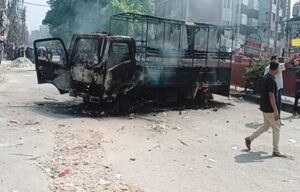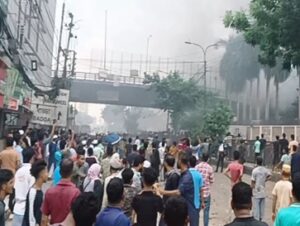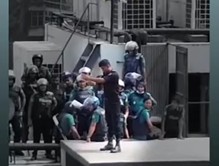The student movement had already intensified since Wednesday, so on Thursday, I decided I’d go too. Woke up around 11 in the morning, opened Facebook and saw—Brac University had been severely attacked. Police opened fire inside the campus. Heard a student from Imperial was killed. It’s worth mentioning, Brac isn’t too far from my place, maybe about two kilometers. I’m currently staying in Wapda Road, Rampura. So I made up my mind—I’ll head to Brac.
As I stepped onto Rampura Main Road, I saw not just the road, but all the nearby alleys were filled with people. From the entire stretch of Rampura Bridge to Abul Hotel—at the very least, there had to be two lakh people. So many people…!

Photo 1: A tidal wave of thousands surging through Rampura
One striking thing I noticed—there weren’t many students visibly wearing ID cards. At first, I couldn’t even tell which group they were from. I had my Buet ID card in my pocket, and if they turned out to be from Chhatra League, I’d be in for a proper beating. So I kept the ID hidden.
Later, I asked someone—they said, “These are student masses.”
Right after that, I saw a group of injured students, all wearing ID cards around their necks. After a while, I began recognizing everyone. They were students like me, with IDs tucked into pockets, and ordinary people from all around.
No political party can bring out two lakh people within a two-kilometer radius. Everyone nearby had come out spontaneously—to demand justice for the student that was killed.
Right after stepping out, I saw a police van at the mouth of the Boubazar alley—burned to ash. Realized things had already escalated early in the day. Chants and slogans echoed endlessly from all sides. Fires burned in the middle of the road—fueled by tree trunks and branches from the dividers. Streetlamps lay toppled nearby, cement blocks of the divider scattered, police barricades dismantled—the entire road now belonged to the students and the masses.

Photo 2: The burnt police van
I decided I would go to Brac, and moved forward in that direction. Under the overbridge in front of BTV, the crowd had taken position—angry and shouting slurs at BTV for airing news about pomelos instead of the protests. Suddenly, a group rushed toward the gate beside the BTV foot-over-bridge and started smashing it. Punches, kicks, blows, and shoves—until the gate came crashing down. But finding nothing much inside, they began pelting bricks.
That day, only a handful of students but a lot of ordinary people in lungis were there. I even saw local teenage gang-type boys.

Photo 3: The WarZone Near BTV
I walked a little further, and it felt like the sun was slowly leaning westward. As I moved ahead, I saw the first gate beneath the BTV U-loop had already been broken down. Didn’t see many people in front of that first gate. Bricks, sticks, and barricades lay scattered across the road. I didn’t stay there long and kept walking forward.
When I finally reached in front of Brac University, there was a surge of countless students and ordinary people. Someone told me that it was the morning gunfire that had driven common people to the streets, and that the police were supposedly trapped on the roof of Canadian University. I moved in that direction to see for myself.
From a distance, a helicopter was visible. I thought they might be deploying troops. But as I came near the Merul U-loop, what I saw with my own eyes—like a scene straight out of a movie—
From the helicopter, they were deploying ropes, and they were pulling people out, hanging midair.
I thought—perhaps, finally, this was the day that their training is being put to real use.
Another thing to witness—on both sides of Canadian University, and atop the Merul U-loop, there were more people than what you’d find in a packed Jummah prayer.
Everyone was shouting slogans, and like me, watching the rescue unfold above.

Photo 4: Police being lifted midair from the rooftop by helicopter
The first two floors of the university building were completely destroyed.
Suddenly, a police officer stood at the edge of the roof and began folding his hands—pleading for forgiveness.
The crowd below erupted in anger, cursing him relentlessly.

Photo 5: Police officer begging for forgiveness — later collected from a video
After watching this scene for half an hour, as I was returning, I saw the roads ravaged by the morning’s clashes. Just like in Rampura—fires everywhere, students chanting, ordinary people keeping pace beside them. Some were handing out water, some giving food, others saline—it was pure, spontaneous participation.
I saw someone taking a photo holding a baton dropped by a fleeing officer. Another had a police boot hoisted atop a pipe. One man stood silently—his neck to chest and back marked with at least 30 (I counted 28 later from a photo) rubber bullet wounds. I don’t know how he was even alive—he stood still, talking.

Photo 6: A body torn by rubber bullets
Then, on my way back, I passed East West University too. There too, the crowd was massive.
When I climbed onto the Rampura Bridge, I realized—the police had arrived.
I thought maybe I could still take the main road, but a bit further on, I saw tear gas shells being fired—right in the direction where I stood. My brain began working at lightning speed. Because the police were blocking the main road, to reach Rampura now, the only way I have is to go through— Hatirjheel
Just then, a tear gas shell landed in the narrow stretch connecting Rampura Bridge to Hatirjheel. In 2–3 seconds, I decided—if I want to survive, I’ll have to run through it.
And I ran.
Right before I took off, I paused a few seconds to look down from under the bridge—all the way to Abul Hotel. Those 2–3 seconds—I will never forget.
It felt like a scene from a zombie movie—
A burned-down CNG, behind it a tree, next to that a barricade—
At least 4–5 layers of barricades everything turned into debris.
And as far as the eye could see—
Tear gas smoke clouded the air, the sound of gunfire all around—
It truly felt like I was running through the war-torn corner of a battlefield in a country at war.
That tear shell I took, right inside that alley facing Hatirjheel — that was the first tear shell I inhale. Even though I had a mask on, I ran for my life through that smoke. The tear gas burned through my nose, forehead, and eyes. But because the movement was so spontaneous, someone lit a tissue paper and said,
“Bro, come this way, take the smoke, feel the heat, don’t use water, you’ll be fine.”
“How to cure tear gas with Fire” — first time in life I learned this kind of science. After the shelling stopped, I returned to Rampura through Hatirjheel.
Coming near home, I saw even here the chase and counter-chase was still happening.
My friend, on his way back from work, got stuck. I helped him find a route home.
There were still crowds of people on the streets and word spread that the police had taken position in front of BTV.
After my friend arrived, we stood on one side, watching the situation. It must’ve been around 5:30 in the afternoon.
Suddenly, we saw smoke rising from the BTV building —
So thick and black that we could see it even from nearly a kilometer away. We understood: BTV had been set ablaze — the rage of years of flattery and propaganda, finally vomited out.
While we were watching all this, suddenly, like a movie, a black helicopter flew in barely below the height of a five-story building — and fired a shot.
We were all stunned.
As soon as i saw the fire from the rifle, I ran.
But my friend — he stood there like a statue, shocked by the moment. The bullet landed just a few feet ahead of us. By sheer luck, no one was standing there, no one got hit in the head.
My friend said, “Look, bro, the bullet shell!” I couldn’t believe my eyes — what did I just witness? A shot fired from a flying helicopter?
After that, none of us stayed on the main road. We scattered after a while. Around 9 PM, I went out again. There were still at least a hundred thousand people on the road. The chants were still echoing.
What a day it was.
The story could’ve ended there — But at 1am, one elder brother from the next room(as we are living in bachelor mess) said, “Let’s go out again.”
We decided to.
For the fourth time in a single day, I returned to the streets — because the sound of grenades was still going on. My brother and I took the Wapda road and went out again.
Once out, we saw about a hundred people in the alley, throwing bricks toward the main road. Curious, we moved closer to see.
From a distance, looking toward the main road, we saw nearly 500+ police lined up — in layers, in ranks —
15 to 20 in a row, row after row. Shotguns sticking out of APCs in the front, middle and back. Police cars flanking the sides. It felt like we were watching a military parade but instead of a dummy parade they were firing rubber bullets, sound grenades, and tear shells, sweeping the streets clean. From one alley after another came the sounds of grenades and gunfire.
But they couldn’t stand near the alleys too long, because bricks were raining down on them nonstop. My brother and I kept walking until we reached the very front of the main road at the mouth of Wapda Road alley.
We both had bricks in our hand. We were just setting our range —
And just then, out of nowhere an APC backed in reverse gear from the front and stopped.
Without giving a second, they began firing. Thank God my head was already down. That brick on my hand never got thrown. I ran sideways and somehow ducked into a small corner by a shop.
Then they turned toward the alley and started firing pellets.
Round after round. The shutters of all the shops were tin and iron — and from every direction, it sounded like marbles hitting tiles.
I stood straight, leaning against the shop. Somehow, the first wave passed.
Suddenly I looked beside me — my roommate brother was gone.
Later, stepping out from the corner, what I saw — I couldn’t believe my eyes —
My brother was crouching right at the head of Wapda road, under the police barricade!
While we were all a few hundred feet behind the main road,
he was right by it —
an APC aiming straight toward him but because the barricade was a solid metal & it was nighttime —
and just 5 meters away, he was hidden from the APC,
brick in hand.
Even while seated, he was still throwing bricks.
After seeing this scene,
not just me — the entire Wapda road was stunned!
It was 1am.
We were a hundred people throwing bricks in the street —
but Brother was leading it all.
One brick after another. He gained an infinite aura that day.
Then the police started firing again. This time, he couldn’t stay either. Eventually, we returned home.
But what I saw that night —
undoubtedly the best night of 2024.
And my elderly roommate —
his infinite courage made my whole chest swell with pride.
This article is the first installment in a three-part series by Md Abu Jafor Tusar.

